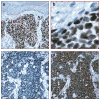Merkel cell carcinoma: a virus-induced human cancer
- PMID: 21942528
- PMCID: PMC3732449
- DOI: 10.1146/annurev-pathol-011110-130227
Merkel cell carcinoma: a virus-induced human cancer
Abstract
Merkel cell polyomavirus (MCV) is the first polyomavirus directly linked to human cancer, and its recent discovery helps to explain many of the enigmatic features of Merkel cell carcinoma (MCC). MCV is clonally integrated into MCC tumor cells, which then require continued MCV oncoprotein expression to survive. The integrated viral genomes have a tumor-specific pattern of tumor antigen gene mutation that incapacitates viral DNA replication. This human cancer virus provides a new model in which a common, mostly harmless member of the human viral flora can initiate cancer if it acquires a precise set of mutations in a host with specific susceptibility factors, such as age and immune suppression. Identification of this tumor virus has led to new opportunities for early diagnosis and targeted treatment of MCC.
Figures








References
-
- Toker C. Trabecular carcinoma of the skin. Arch Dermatol. 1972;105:107–10. - PubMed
-
- Engels EA, Frisch M, Goedert JJ, Biggar RJ, Miller RW. Merkel cell carcinoma and HIV infection. Lancet. 2002;359:497–98. - PubMed
-
- Agelli M, Clegg LX. Epidemiology of primary Merkel cell carcinoma in the United States. J Am Acad Dermatol. 2003;49:832–41. - PubMed
-
- Hodgson NC. Merkel cell carcinoma: changing incidence trends. J Surg Oncol. 2005;89:1–4. - PubMed
Publication types
MeSH terms
Substances
Grants and funding
LinkOut - more resources
Full Text Sources
Other Literature Sources
Medical

